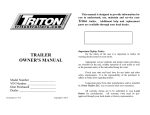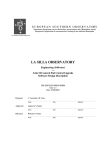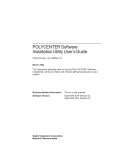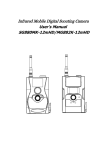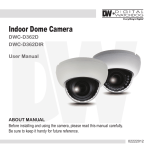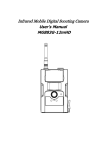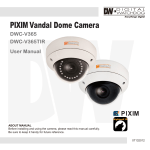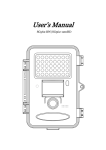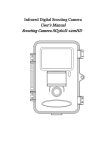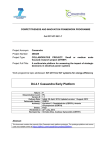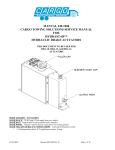Download Triton Trailer User Manual
Transcript
This manual is designed to provide information for you to understand, use, maintain and service your Triton trailer. Additional help and replacement parts are available through your local dealer. Important Safety Notice TRAILER OWNER’S MANUAL For the safety of the user it is important to follow all warning decals posted on your trailer. Appropriate service methods and proper repair procedures are essential for the safe, reliable operation of your trailer as well as the personal safety of the individual doing the work. Check your state and local laws for any brake and other safety requirements. It is the responsibility of the purchaser to adhere to brake laws regarding trailers. Model Number _________________ VIN Number ___________________ Date Purchased _________________ Dealer ________________________ ownerman rev 4-13 -04 Copyright © 2013 Component parts from other manufactures sold or installed by Triton Trailers LLC are covered by their own warranties. All warranty claims are to be submitted to your Local Dealer for consideration. All warranty work must be pre-approved through your local dealer or factory representative. Consult your state and local laws regarding length or width restrictions of trailers on certain highways or roads. SUGGESTED PRE-TRIP CHECKLIST MAINTENANCE There are a number of guidelines to follow in caring for your Triton trailer that can add years to its life. In the case of some of these guidelines, you may be protecting your own life as well. Using the following checklist before starting a trip with your trailer is required. Some of these items should be checked 2-3 weeks prior to a planned trip to allow sufficient time to perform maintenance. Check your maintenance schedule and be sure you are up-to-date. Check that the hitch is properly lubricated and not showing excessive wear. Fasten safety chains securely being sure to crisscross chain. Inspect towing hookup for secure attachment. Load your trailer so that approximately 7-10% of the trailers total tow weight (GVW) is on the hitch and the trailer is level. This total tow weight includes all gear, gas, trailer and cargo weights. For lighter trailers this percentage should be increased slightly. DO NOT OVERLOAD. Stay within your gross vehicle rated capacity for your tow vehicle and trailer (GCWR). Maximum carrying capacity is calculated by subtracting trailer weight from GVWR. (Consult your local dealer for capacity information). Inflate tires according to the manufactures specifications located on the side of the tire. Inspect for cuts and excessive wear and weather effects. Check wheel mounting nuts/bolts with a torque wrench. Torque lug nuts to 85ft/lbs. If applicable; make certain brakes function properly. Check operation of all lights. Check that your trailer is towing in a level position and adjust hitch height if required. Check that all cargo and accessories are correctly installed and properly secured to trailer both front and rear. Commercial vehicles must have operator/cab control of the trailer brakes to be legal. Consult your state and federal laws to be assured you are in compliance. Coat tie down screws with anti-seize periodically during the season. Grease sure-loc tie downs (if applicable). Always maintain the recommended air pressure in tires. This can be found on the sidewall of the tire. Follow all maintenance procedures in your axle manual and actuator manual, if applicable. Clean trailer periodically with aluminum cleaner available at your local dealer or auto parts store. If rust develops in the master cylinder, replace it immediately. Failure to do so will result in non-warrantable brake system failure. To prevent corrosion periodically coat electric plug with dielectric compound, available at your local auto parts store. Check and lubricate bearings every 6 months or 6000 miles, or more often, based on usage. It is a good practice to grease bearings in spring and fall. Bleed brakes every 12 months or 12,000 miles, or more often, based on usage. Periodically spray mechanical moving parts such as the hitch and suspension parts that are exposed to the weather, with petroleum based penetrating lubricant available at your local auto parts store. SEASONAL STORAGE CHECKLIST If your trailer will be unused for more than one month: If applicable, remove tie down screws. Block up trailer under the frame to avoid flat spotting of tires. Follow all storage procedures per axle manual. Coat electric plug with dielectric compound. Check master cylinder for proper fluid level. Lubricate all mechanical moving parts exposed to the weather. Spray metal brake components with a penetrating lubricant with Teflon to help prevent corrosion. For grease specifications refer to the manufacturer’s Axle Service & Maintenance manual. TOWING TIPS Always check for properly functioning braking system before and after trip. Be sure all brake lines are free and clear of obstructions and brake fluid is at a proper level. Be aware of turning limitations when using a bumper mounted ball hitch. Non-warrantable damage will occur if trailer is “jack-knifed”. Trailer tires do not come balanced and may need to be if you are experiencing vibration while towing. This is part of normal maintenance and is the responsibility of the owner. If hauling a wheeled vehicle you may need to add a wheel pad to disperse weight. Be sure to properly balance your load. Benefits will include: -less stress on tow vehicle -better ride -less rattling -reduced sway of trailer -safer hauling experience When hauling a shiftable cargo you must secure both front and rear of cargo to trailer using appropriate tie down bars and/or ratchet style straps. Proper towing performance will be achieved by maintaining 7-10% of trailer’s GVWR in tongue weight and correct tongue height. DO NOT OVERLOAD. Stay within your gross vehicle rated capacity for tow vehicle and trailer (GCWR). Be sure your hitch and trailer are sized properly according to the vehicle’s manufacturer recommended capacity for towing. Do not exceed the vehicle’s “Tow Rating” or exceed the GVWR or GCWR. TROUBLE SHOOTING Lighting & Wiring System Most lighting systems are sealed and therefore DO NOT ground through the ball; and require a good vehicle ground. The ground wire (white) should be the first thing to check; even if it is factory installed. This is the most common problem. Hook up trailer wire to another tow vehicle to determine if lights are working properly. This will eliminate a possible problem with the tow vehicle. Check light element with similar light on trailer to determine if the bulb has burned out. Most lights are sealed and you must replace the entire unit if the bulb burns out. When replacing a wire harness plug, all similar colored wires are connected together. Example: the two white ground wires from the harness are connected to the white ground in the plug. All replacement lights, lenses and wire harnesses can be purchased through your local dealer. 5 ELECTRIC BRAKING SYSTEM Proper brake adjustment is important. Check with the axle manual or your local dealer for brake adjustment information. Check brake system before and after trip. If brakes are not functioning properly: Check electrical hook-up. Check for power at wheels. Be sure Breakaway Battery is fully charged. Under normal conditions, 4-5 years in standby applications or 200-1000 charge/discharge cycles depending upon depth of discharge and rate of charge. SURGE BRAKING SYSTEM Proper brake adjustment is important. Check with the axle manual or your local dealer for brake adjustment information. Check brake system before and after trip. If brakes are not functioning properly: Check for blockage in free backing valve and brass reducer valve located behind the actuator. Electric Brakes Check that the master cylinder is filled properly. Improper installation of the breakaway battery will destroy the brake Check for air in the system by bleeding. control. The negative terminal must attach to ground and positive terminal Note; some calipers have two bleeder screws, use the upper one when bleeding. must attach to the breakaway switch. After initial bleeding, a slight tap on the caliper Check your breakaway system periodically to insure that wiring and with a soft hammer or a block of wood will connections are secure. A short or an open circuit can result in a nohelp bring the air to the top. Continue to bleed 1 - 0508489 Caliper Assy, RH (10” brake) brake condition. 2 - 0508488 Caliper Assy, LH (10” brake) system until all air is removed, checking master If excessive discharging of the breakaway battery occurs, check battery 1 - 0509286 Caliper Assy, RH (7” brake) cylinder fluid level to be sure it does not go and recharge using a Heavy Duty Two Stage/Maintenance Charger. If 2 - 0509285 Caliper Assy, LH (7” brake) empty. 3 - 0508487 Rotor Assy (10” brake) using a commercial (AC to DC) make certain the 12-volt charge is 3 - 0509284 Rotor Assy (7” brake) limited to 1.2 amps or less. 3a- 0506320 Bearing 1-1/16 If the secondary battery needs charging, current will be drawn from the 3a- 0506434 Bearing 1-3/8 (10” brake) 3a- 0506433 Seal (10” brake) tow vehicle’s battery at anytime the tow vehicle is connected to the 3a- 0503837 Seal (7” brake) trailer. The most current which will be drawn is 1.2 amps. 4 - 0509469 Bottle Cap Retainer (Dexter) To charge the breakaway battery when vehicle is running, a battery 4 - 0509468 Spindle Jam Nut (Dexter) 4 - 0509467 Spindle Washer (Dexter) isolator may be installed in the 12-volt supply line (Black wire for tow 4 - 0503846 Tang Washer charger). Battery Data Chart 12 VOLT P/N 1023 – 4 amp/hr – max discharge current 20 hr rate = 225mA P/N 2023 – 5 amp/hr – max discharge current 20 hr rate = 250mA Maximum Discharge Current = 40 amps Maximum charge current must be limited to 1.2 amps P/N 1023 & P/N 2023 Length = 3.54” Width = 2.76” Height = 4.13” Weight = 3.8 lbs Terminals: Fasten Tab .187” x .032 Service Life: 4 - 0503847 Spindle Nut (Reliable) 5 - 0503848 Dust Cover (Dexter) 6 - 0503849 Rubber Plug (Dexter) 6 - 0507696 Grease Cap (Reliable) 7Brass Fitting Tire Information Please refer to “Tire Safety Information” available at www.tritontrailers.com under the Owner’s Manual section. This





